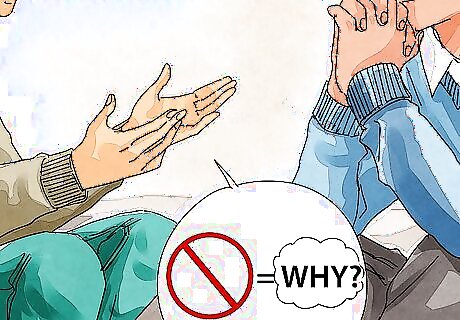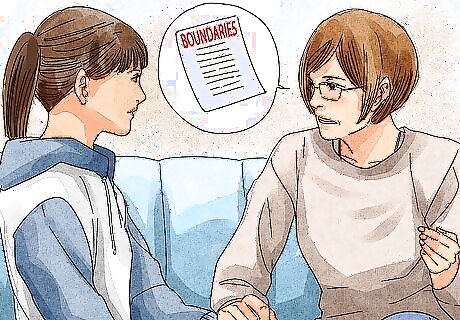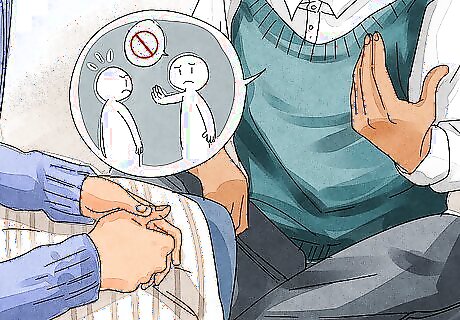
views
Choosing Your Limits

Make your own well-being a priority. Many people fail to set personal boundaries because they feel guilty about it or think their needs don’t matter. However, your needs are just as important as anyone else’s, and you have to be in good mental and emotional health to be able to help others and fulfill your own responsibilities. Setting boundaries you’re comfortable with isn’t selfishness – it’s your right. In the long run, healthy boundaries don’t only benefit you. They also benefit your loved one with BPD by creating a clear sense of structure and predictability in the relationship.

Define your boundaries. Determine ahead of time which limits you are going to establish with your loved one and why. One good way to define your boundaries is to think about your values. Good boundaries are a way of protecting the things that matter to you most and ensuring you aren’t pressured into activities or situations that go against the way you want to live. For instance, if your friend wants to talk on the phone with you every night, but you value spending evenings with your family, you might decide not to take your friend’s calls after five o’clock.

Decide on follow-up steps when your boundaries are crossed. It's important to think about what action you will take if your loved one does not respect your boundaries. If you don’t specify what your reactions will be and follow through with them, your loved one will probably not take your boundaries seriously. A good follow-up step should be something that follows naturally from the other person’s actions. For instance, you might decide that if your partner shouts at you again, you will leave the house for a few hours until they can calm down.

Prepare yourself for your loved one’s reactions to your boundaries. The other person may be angry, hurt, or embarrassed when you tell them you need them to behave differently. They may take the change personally, accuse you of not loving them, or act out against the boundaries. Decide how you will handle various reactions so you aren’t caught off guard when it happens.
Having the Conversation

Choose a time when you and your loved one are calm. Talking about boundaries can be a touchy subject. Make the conversation a little easier by talking with the other person at a time when you’re both emotionally stable. Avoid introducing the topic of boundaries during or right after a fight. If the other person feels defensive or angry, the conversation won’t be productive. Introduce the topic by saying something like, “Are you free for a minute? There’s something I’ve been wanting to talk with you about.”

State your boundaries clearly and firmly. Be upfront when you tell your loved one about your new boundaries. Be kind, but don’t apologize or back down. Explain exactly what you need from the other person without any ambiguity. Use a calm, non-confrontational tone to lessen the risk of the other person taking offense.

Explain why you are setting these boundaries. For your loved one, hearing about the new limits you’re imposing on the relationship might sting. However, it’s important that they understand why you’re doing it. Be gentle but honest about your reasons. Phrase your explanation in a non-accusatory way that focuses on your needs instead of what the other person is doing wrong. For instance, if you find your spouse’s mood swings exhausting to deal with, you could say, “It’s really wearing me out trying to guess how you’ll be feeling from one day to the next. I need you to communicate your feelings to me more regularly.”

Reassure your loved one that you value them. Someone with BPD may feel insulted when others set boundaries with them. Make sure to give your loved one plenty of reassurance that you’re not rejecting them as a person and that your relationship with them is still important to you. Emphasize the ways your boundary will benefit both of you. This will help your loved one understand that you’re not setting limits just to try to push them away. For instance, you could tell a friend, “I think spending more time on our own will be good for both of us in the long run. I have more energy for socializing when I spend enough time alone, so we’ll both have more fun when we do get together.”

Avoid letting the other person make you feel guilty. Your loved one may try to make you feel bad for setting boundaries. Don’t let them sway you with emotional manipulation. You have the right to protect your own well-being.
Following Through

Carry out any set rules and reactions you’ve established. If the other person doesn’t respect your boundaries, follow through with your follow-up steps consistently. It’s important to follow through every time. Otherwise, they will get the message that you’re not serious about your boundaries. Once your loved one realizes you are serious about your boundaries and rules, they may accept them and stop testing you.

Avoid giving an ultimatum unless you mean it. When you’re frustrated with your loved one’s behavior, it can be tempting to make an ultimatum, just to try to get them to cooperate with you. However, ultimatums lose their power if you don’t intend to follow through on them. Avoid giving an ultimatum unless you’ve thought it through and are fully prepared to carry it out.

Stay flexible. Setting and maintaining boundaries is a process, not a one-time event. Don’t hesitate to change your boundaries if you find that something isn’t working for you. Communicate with the other person about changes in boundaries so you stay on the same page about what you both expect from the relationship.

Distance yourself if you need to. Sometimes even the best efforts to set healthy boundaries don’t improve a relationship with a person who has BPD. If the person refuses to cooperate with you or acts abusive towards you, it’s probably best to end the relationship. Put your safety and sanity first – you’re under no obligation to maintain a relationship or friendship with someone who doesn’t respect you or your needs.
Understanding BPD
Recognize the symptoms so you can set fair, compassionate boundaries. Knowing what’s normal and what’s not for a person with BPD can help you decide what boundaries are fair for both of you. For instance, it may upset you when your partner experiences stress-related paranoia, and you may be tempted to set a boundary like, “Don’t approach me with your concerns when they’re unfounded.” The problem with this might is that this paranoia is probably a symptom of BPD that your partner can’t help, and rejecting them when they need you will hurt both of you in the long run. Instead, try saying, “Let me know when you’re experiencing intense paranoia. We’ll talk it over for a few minutes, then I’ll sit close by in the next room while you calm down.” Other symptoms include a fear of abandonment, unstable relationships, changes in self-image, impulsive behavior, suicidal behavior, mood swings, and feelings of anger or emptiness.
Consider the causes of your loved one’s BPD. Though the causes of this mental illness aren’t yet fully understood, it’s possible that environmental factors such as child abuse or neglect may have impacted your loved one’s BPD, as well as genetic or brain abnormalities. Remembering that their BPD may stem from trauma, genetics, or both will help you maintain sympathy when you approach your loved one about setting boundaries. You could say, for example, “I know that your BPD is something you can’t always control, and that it’s linked to a painful time in your past. I don’t want to trigger those bad memories by setting boundaries, I just want to help myself so that I can better help you.”
Understand the nuances of BPD so you can set boundaries more empathetically. BPD is a difficult and tumultuous mental illness, often characterized by an intense fear of abandonment and pattern of intense, unstable relationships. Realizing the effects of these symptoms can help you better understand your loved one’s response to your desire for boundaries. If your loved one experiences this extreme aversion to separation, realize that they may become upset when you approach them with the idea of setting personal boundaries, seeing it as a rejection or pulling away. They may think about difficult past relationships and be afraid that they’ll lose you as well. Approach your loved one with compassion and empathy, reassuring them that you’re not going anywhere and that you simply want to help both them and yourself.
Help your loved one through their BPD. Offer to visit the doctor with them, spend quality time with them doing something you both enjoy, and tell them you love them. Showing your love and support will make them more willing to see your point of view and help them understand your desire for healthy boundaries.


















Comments
0 comment